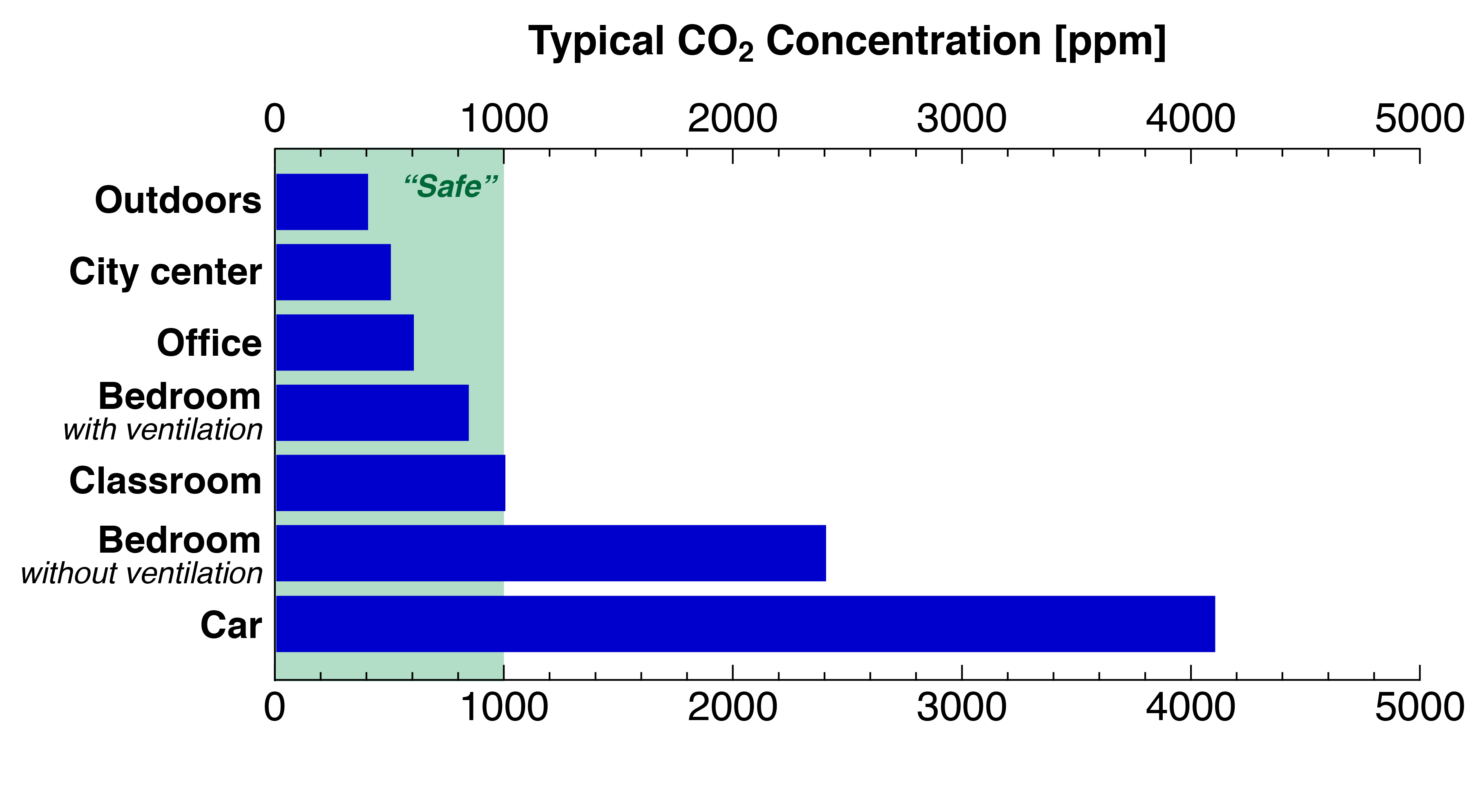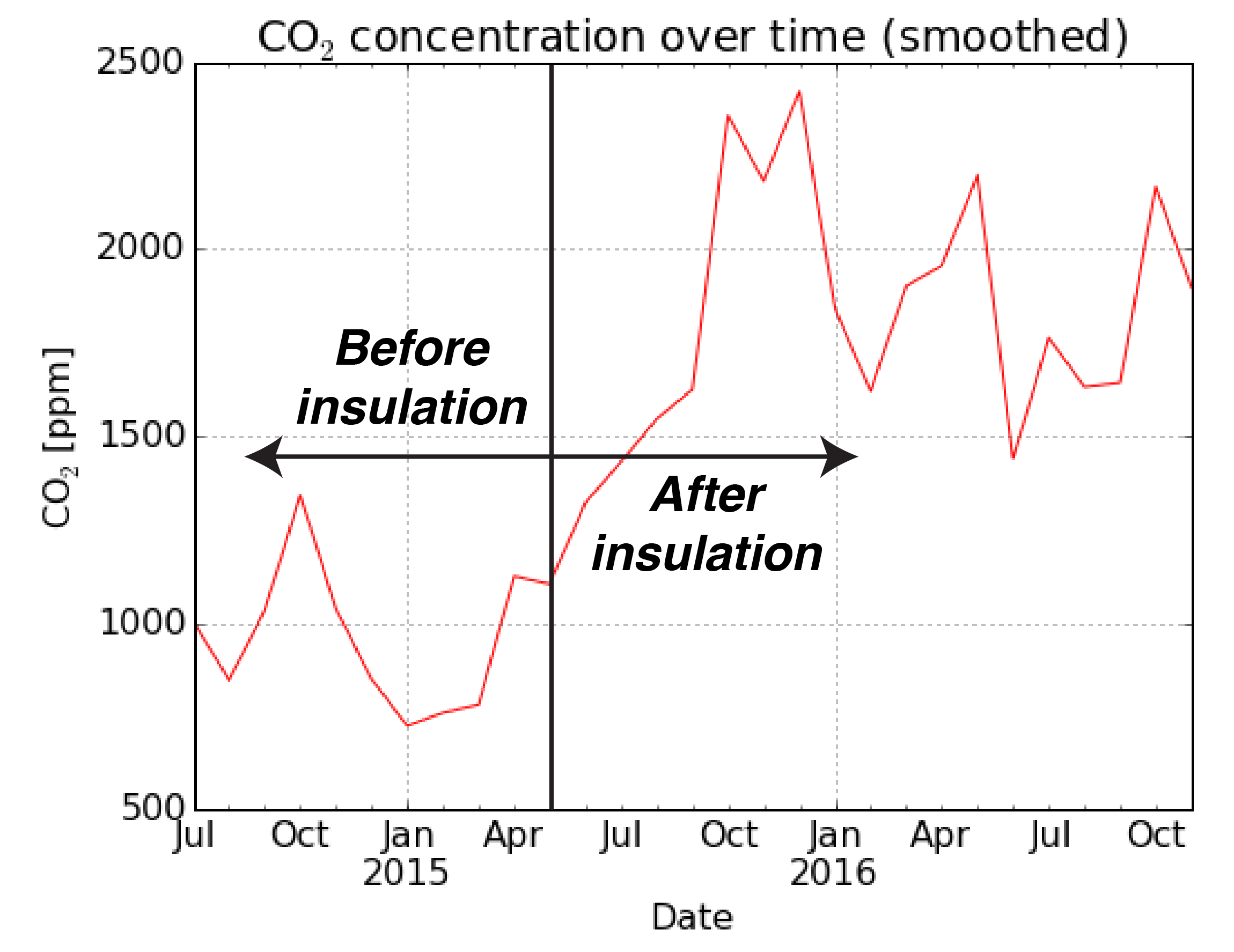
I learned a few new things about CO2 that I did not know recently.
Humans exhale over 2 lbs of CO2 every day. Somebody physical exertion much of the day can exhale 8 lbs/day.
That reads like a lot and was easy to find but I wondered what does that mean?
More the weight aspect later but it's sort of like this would be the weight of the amount a magical carbon capture unit hooked up to our mouths all day would precipitate out in pure, solid carbon at the end of the day.
But I still did not know the important thing. How concentrated is the CO2 exiting your mouth and how long might it take to build up in a room?
Turns out that the concentration leaving our mouths is around 38,000 parts per million compared to the ambient 418 ppm. This is around 100 times more concentrated than the air surrounding us. This quickly dissipates.
If I wanted to be really smart, I could try to calculate the exhaling volume of 1 person's CO2 and compare it to the total volume of air in the room with zero air flowing in/or out and come up with a rate of increase in the CO2 in the air.
I might have to use some advanced math/calculus, taking into account things like the CO2 in the room gradually increasing with time and the person inhaling that newer air and this affecting the new rate. But I'm not smart enough or have the time and the observation of the REAL WORLD is measured for me at a couple of articles/links on the internet that I can pass along.
I read that they often test to see if a house has enough ventilation by measuring the CO2 level.
These are just some general articles below with good info. I had no idea that CO2 can get up to 4,000 ppm in your car!!!
Another thing that I learned recently is that the word "carbohydrate" comes from the source/word........carbon. This is based on plants using CO2 to produce food/sugars from the CO2.
metmike: Personally, I think the author of the article below is exaggerating. However, he does have some very interesting information and points that I did not know.
https://medium.com/@joeljean/im-living-in-a-carbon-bubble-literally-b7c391e8ab6


CO2 levels in my bedroom before and after adding insulation in May 2015
Mike,
Fascinating stuff! Thanks for posting!
I wonder if this could be a significant issue for mainly bedridden folks like my bro. He does use a CPAP like your wife as I said, but isn’t that just recirculating room air? When he’s in his bedroom (~97% of the time), he likes his door mainly closed (practically ajar) because he keeps his room warmer than the rest of the house (including the hallway just outside his room) since he gets cold so easily. Because of this, he often likes his central air vent to be closed.
He does have a machine that constantly runs with some kind of filter that the air goes through, but I don’t see how that would reduce CO2 in his room
I need to ask his doc if this could be a significant health factor. He is tired and sleepy much of the day, but I attribute much of that to a combo of his meds, his condition (including being out of shape due to being in bed so much) and insomnia at night.
Is it possible that a portion of his sleepiness is due to likely relatively high CO2 levels in his room?
I wonder if it would be helpful for both of us to run the central fan all of the time, especially when neither heat nor AC come on much. Any thoughts?
I read that there’s a CO2 meter that one could buy. I wonder if that would be a good thing to buy assuming it is accurate. I’d like to see what the CO2 is in my bedroom, too, since I have my door almost always closed or ajar because it helps me to concentrate when I’m working during the day or keeps it darker and quieter for better sleep at night. Then again, getting this meter may end up leading to unnecessary worry by both of us about something that would be difficult to resolve. We both get worried easily about medical stuff as it is. We don’t need something new to worry about.
Thanks very much Larry,
This is the sort of research that I love doing because it involves learning new things about something fascinating.
You obviously know my opinion on CO2 being a beneficial gas but despite that, I'm totally capable of applying the scientific method and looking for reasons that I might be wrong..........in fact that should always be the main objective or all scientists.
With that in mind, you can expect more from me on this.
My impression about this inform right now.
1. Though shocking, at the same time its exiting to learn. We only learn, when we didn't know something before.
2. It's not like I haven't read thousands of articles and seen all the OSHA, FDA, EPA and so on's literature on the regulations and safety levels for CO2 the past 20 years. That's what makes this so shocking because I've not seen a discussion like this.
3. I have seen data spun way out of context in this realm by people who's objective is to spin data for their anti fossil fuel, anti CO2 agenda based on a political ideology.
4. Because this person is a student at MIT and I'm looking at his data and presentation, I very much appreciate his scientific prowess. But brilliant climate scientists in the 1990's completely bamboozled me in the 1990's too. I totally trusted them on several items. I actually understand why they thought what they did then with their theories too. But 2 decades later, when the amount of warming they want us to believe in is at least double the amount that we know with extreme confidence is actually happening..............shows that they are misrepresenting the authentic science and are very biased.
5. I am no medical expert on the legit affects of CO2 on humans, although I thought that I was pretty smart about it. I am a mega, super duper expert on CO2 and plants(looking at data from thousands of studies and articles and understanding the agronomy and biology of photosynthesis) but not on humans...............yet.
6. This smart guy is a student at MIT................presenting himself as an authority on the affects of CO2 on the human body. Somehow, all the authorities discussing the CO2 as pollution narrative have missed his points to date?
7. The reason for this could actually be because the solution to too much CO2 in your house, business and car is so easy to fix. Circulate in a bit of outside air, with very safe levels of CO2, even if they were much higher outside, at 418 ppm........problem completely solved. The solution would not be to stop burning fossil fuels because the outside ambient/atmospheric level will NEVER get close to being higher enoughto to be dangerous for humans to breath. 900 ppm is optimal for plants and still save for humans. We are less than half of that.
8. However, going from less than 300 to 418ppm during the last 100 years, would mean the outside air coming in does not have quite the same diluting power as it did before. If we get to 500 ppm or even 600ppm(which I think is tops for even the most extreme max, guesstimate) the solution to high indoor CO2 is still to bring in outside air....just a bit more of it.
9. This is just the sort of rationale that a brilliant, liberal MIT student would use to impart a new scary threat about the climate crisis scare.
10. But I will be open minded and try to find(as hard as it might be) OBJECTIVE analysis of how increasing CO2 affects humans at different levels.
11. As it turns out, the reason that I stumbled on this information is that I am working with a group on a carbon capture process and I am serving as their environmental and atmospheric scientist. One of my colleague's and now good friend who is our engineer, bought a couple of CO2 meters to measure the device/machine/invention. When he was initially giving me his readings in the house, I insisted that they were broken, several times......that the readings were just too high. Then he put them in his bedroom, with the door closed overnight and readings sky rocketed........EVERY time and consistently. Empirical data ALWAYS wins the science. It's way more powerful than models and way more powerful than preconceived notions or previous assumptions. It's for real. HE taught ME something in an area that I thought I was the ultimate expert on. Since then, I have been trying to build on this newly discovered knowledge and applying my understanding of the science to this new area of the CO2 realm.